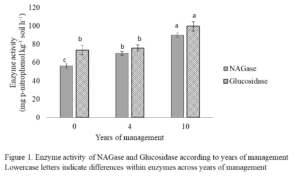Final report for GS16-158
Project Information
- The problem addressed was the need to measure and quantify the effects of pasture management on soil health over time.
- The research approach was two-fold: One cattle producer had used winter annuals and mob grazing on his pastures for eight years. We began soil sampling his fields in 2015 and continued through 2017 to measure the changes or lack thereof in soil health. The majority of expenses for this “site one” were funded by a CIG grant but a small portion of the expenses were funded by the Southern SARE grant. At “site two”, the second cattle producer had three separate pastures that he had subjected to management for 0 years, 4 years and 10 years. This allowed us to compare the effects that use of winter annuals and rotational grazing had on soil health at a given time. This project was entirely funded by the Southern SARE grant.
The information gathered from these projects was presented to producers and agriculture extension agents at regional, state, and national conferences. Livestock producers could use this information to have some reasonable expectation of what would happen to their soils within 10 years of using winter annuals and rotational or mob grazing. - From this research, it was concluded that total carbon and total nitrogen did not change with date of sampling though soil organic matter (SOM) did increase by 6% in site one. Nitrate concentrations decreased by 82% within two years at site one and remained consistent at 2.15 mg kg-1 at site two. Potential soil microbial enzyme activity increased with increasing years of management (grazing and winter annuals) by 27% and over time by 32% at site one and an average of 70% at site two. Total microbial abundance did not change over time at either site. Soil microbial community structure responded to abiotic conditions (e.g. season and topography) but not to years of management. This pasture management technique of over-seeding a diverse mix of winter annuals may, with time, allow for a steady state of carbon and nitrogen while SOM increases and inorganic nitrogen decreases, and enhance the total soil microbial community and their potential enzyme activity.
- Determine how long term inclusion of winter annuals in a perennial pasture affect soil health;
- Compare soil health under earlier stages of similar management strategies.
Research
Soil samples were collected twice per year: spring and fall. The soil samples were collected using a soil corer of 10.16 cm diameter to a depth of 30 cm which were sectioned into four 7.5 cm layers. Three samples were collected at three areas of each site for pseudoreplication at each depth for a total of twelve samples per site. The 0-7.5 cm and 7.5-15 cm depths were analyzed for biological properties and were transported in coolers and stored at -20°C. Analysis of total carbon and nitrogen; the nutrients phosphorus, potassium, calcium, magnesium, copper, sodium, sulfur, and zinc; and soil pH were carried out by the LSU AgCenter Soil Testing and Plant Analysis Laboratory on the LSU campus. Ester Linked-Fatty Acid Methyl Ester (EL-FAME) analysis identified phospholipids in the soil belonging to specific microbial groups which provided information about the presence and abundance of the microbial groups such as Gram(-) bacteria, Gram (+) bacteria, actinomycetes, saprophytic fungi, and arbuscular mycorrhizal fungi. Gas chromatography was used in this procedure. To determine the nutrient cycling activity of these soil organisms, two enzyme analyses were conducted. The first was the β-glucosidase analysis which provided information about the carbon cycling activity of the soil organisms. The second was the N-acetyl-β-glucosaminidase analysis which provides information about the nitrogen cycling activity. The methods used in these analyses were following those of Tabatabai (1994). Soil nitrate and ammonium, the inorganic and plant available forms of nitrogen, were determined through potassium chloride extraction and filtration. For nitrate, a vanadium chloride reagent was added and the solution incubated for one hour in the dark at 37°C before being analyzed by spectrophotometry. For ammonium, a salicylate solution and a bleach/hydroxide solution were used as reagents and the mixture was incubated for 50 minutes at room temperature in the dark before being analyzed by spectrophotometry. Particle size analysis was used to determine the soil texture or proportions of sand, silt, and clay of the soil. This was done using a hydrometer and a 10% sodium hexametaphosphate solution. Soil organic matter was determined using the Loss-on-Ignition method. First the soil was oven dried at 105°C over-night and then placed in a muffle furnace at 400°C for at least 8 hours. The weights of the sample after drying and after ignition were used to determine soil organic matter content. Bulk density of the soil was determined for each location.
To address first objective, the methods and analyses described above were carried out on a farm (site one) that had been utilizing winter annuals and mob grazing for eight years these methods and analysis were conducted from 2015 to 2017. To address the second objective, these methods and analysis were carried out on site two which had three separate pastures: one that had been rotationally grazed for ten years, one that had been grazed for four years, and one that had just been converted from fallow ground to pasture. The ten year and four year pastures have been planted to a winter annual mixture for the past four years. Comparisons of data across these sites will address objective two. Year 0 is the replication.
At site one, the effects of topography and season had a stronger impact than years of management. SOM at 0-7.5 cm was least in spring 2016 at 59 g kg-1 and greatest in fall 2016 at 70 g kg-1 but had an overall increase of 6% from 2015 to 2017 though there was no significant difference between the fall 2015 and spring 2017 observations. The increased SOM with time may be due to the use of winter annuals which provide a constant source of plant biomass throughout the year when incorporated with warm-season perennials. This biomass contributes to the SOM through root exudates and decomposition. There was no change over time at the 7.5-15 cm depth which averaged 36 g kg-1 of SOM (P=0.301). Winter annual plant species have shallow rooting systems which again may have contributed to the increase of SOM at the 0-7.5 cm depth but not deeper (Mapfumo et al., 2002). However, the roots of perennial plant species penetrate deeper into the soil and are likely contributing to maintain a steady SOM, TC, and TN at the 0-30 cm depth (Mapfumo et al., 2002). From October 2015 to March 2017, NO3--N decreased by 400% which was likely due to the lack of added fertilizers for the past eight years. However, TN did not decrease with time suggesting that there was enough organic N in the plant biomass and animal manure to replace the N lost through leaching or that the NO3--N changed form and did not leave the site.

As for topography, a consistent pattern could be seen across dates of collection in that SOM was least at the Summit2 and Backslope3 compared to all other locations (Table 1). The majority of other measured soil nutrients (TC, TN, NO3--N, NH4+-N, P, and S) and soil microbial abundance were also found to be least at these locations compared to the others. Soil pH and bulk density however were found to be greater at these locations. The observations at the Backslope3 location were likely due to the fact that it had an 18% slope which allows for more runoff and erosion of soil at this location compared to the others. As for the Summit2 location, it may be speculated that intense grazing of that location which would contribute to poor plant growth and high soil compaction were responsible for the lesser concentrations of soil nutrients and soil microbial abundance.
To a depth of 15 cm, the total microbial abundance or total FAME (P≤0.0001) as well as the absolute abundance of GMp bacteria (P≤0.0001), AMF (P=0.0004), total bacteria (Bac) (P≤0.0001) which is the sum of GMp and GMn bacteria, and actino were seasonally affected (Table 2). Total FAME averaged 499 nmol g-1 in October and 364 nmol g-1 in March. Total FAME was more strongly influenced by the GMp bacteria than any other group of microorganisms which may be why total FAME was greatest in fall samplings when bacterial abundance was greatest likely due to the presence of senescing aboveground and belowground plant biomass. However, AMF abundance was greater in spring samplings likely due to the greater abundance of plant roots and actively photosynthesizing plants. Soil P (P≤0.0001) was greatest in the first fall and spring samplings and decreased by 44% in the fall 2016 but increased by 33% in spring 2017 (Table 2). Soil K (P=0.001) declined from fall 2015 to fall 2016 then began to recover in spring 2017 (Table 3). This soil nutrient pattern may be attributed more to the rainfall events and subsequent runoff or leaching losses that occurred over the duration of the project than to the management of the site.


At site two, the soils under this management type (rotational grazing and over-seeding of a diverse mix of winter annuals) did not have an effect on many of the measured soil properties. Soil bulk density in pastures managed for 10 years (1.27 g/cm3) was less compared to the 0 years and 4 years (1.38 g/cm3) (P=0.034). The lower bulk density may be attributed to the greater number of years this pasture has been utilized for grazing. Greater plant production for a longer period of time could have resulted in greater root growth and aeration of the soil while keeping a median stocking density and rotating cattle would have resulted in negligible soil compaction. Soil pH (P≤0.0001) was also greater in the field under 10 years of management (5.95) compared to the other fields (average 5.33). This may also be attributed to the longer duration of grazing of this pasture. Deposition of manure over time may be increasing the concentration of base cations in this pasture (Jenkins et al., 2009). Martins et al., (2016) suggested that grazing may cause the plant roots to mine base cations from deeper in the soil which may increase soil pH.

There was no effect of years of management on the soil microbial community structure or abundance. However, the enzyme activity increased with increasing years of management. β-glucosidase (P=0.002) increased from 28 in 0 years to 33 in 4 years to 42 mg p-nitrophenol/kg soil/h under 10 years of management and N-acetyl-β-glucosaminidase (P≤0.0001) did the same increasing from 25 to 34 to 42 mg p-nitrophenol/kg soil/h (Figure 1). It was unexpected to observe an increase of enzyme activity with increasing years of management without also seeing an increase of soil microbial abundance. However, enzyme activity is positively influenced by soil pH (Hewins et al., 2015) which may account for the 10 year pasture having greater enzyme activity as this pasture had a greater soil pH.
This pasture management technique of over-seeding a diverse mix of winter annuals and rotational grazing without additional fertilizers or lime may, with time, allow for a steady state of carbon and nitrogen while SOM increases and inorganic nitrogen decreases, and enhance their potential enzyme activity. These two sites have reached an equilibrium in which the outputs or losses from the systems equals the inputs to the systems or in other words, sustainability. The response of the soil microbial community to season suggest that these systems are resilient and recover from sudden changes due to weather. However, topography has a strong influence on soil characteristics and must be considered in pasture management.
Educational & Outreach Activities
Participation Summary:
- 6 oral presentations at professional conferences and regional field days: Alliance of Crop, Soil, and Environmental Science Societies. November 2016. Phoenix, AZ.; Soil Health and Louisiana Cover Crop. January 2018. Winnsboro and Alexandria, LA; Acadiana Beef Producers and Iberia Research Station Field Day. March 2018. Jeanerette, LA; ASA & CSSA Annual Meeting. November 2018. Baltimore, MD; Louisiana Forage and Grassland Council. December 2018. Alexandria, LA; American Forage and Grassland Council. January 2019. St. Louis, MO
- 3 poster presentations at professional conferences: Southern Association of Agricultural Scientists. January 2017. Mobile, AL.; Southern Pasture and Forage Crop Improvement. June 2017. Fayetteville, AR; Sustainable Agriculture Research and Education. April 2018. St. Louis, MO
- 3 oral presentations for LSU AgCenter Extension: 2018 Soil Health and Cover Crop Conference had approximately 25 participants. The 2018 Acadiana Beef Cattle Field Day had approximately 100 participants. The 2018 Louisiana Forage and Grassland Council meeting had approximately 100 participants. Participants were cattle producers and extension professionals.
- 2 journal articles are currently in progress. The first will be submitted for publication in Soil Biology and Biochemistry. The second will be submitted to Agriculture Ecosystems and Environment
Project Outcomes
Despite no differences in the microbial community and soil organic matter, there has been a positive relationship between bulk density, soil pH, and microbial activity. There is evidence in this and a second research study in a similar system that suggests that while inorganic N concentrations are decreasing, overall total N remains constant. This would indicate that these winter annuals are aiding in the influx (via legumes) and cycling of N. Improvements in overall soil health in these low disturbance, high input systems may require longer time periods (>10 yrs), but improvements in some sensitive indicators suggesting that the combination of winter annuals and intense grazing may be a viable conservation management practice for pasture ecosystems.
As a graduate student, my knowledge of sustainable agriculture has expanded, and I believe that this project has demonstrated the ability of sustainable agriculture to improve soil health. Katy continues to exceed expectations in progressing towards her doctorate with her management of course loads and research requirements. She has stepped into the role of project manager for this research successfully and continues to meet the goals she has set.
Through the work done here Dr. Fultz and Katy have been invited to attend and meet with various producer groups to discuss the importance of soil health outside the existing AgCenter's scheduled field days and workshops. There appears to be a growing interest in the potential use of and benefits associated with winter annuals in both pasture and row crop management.